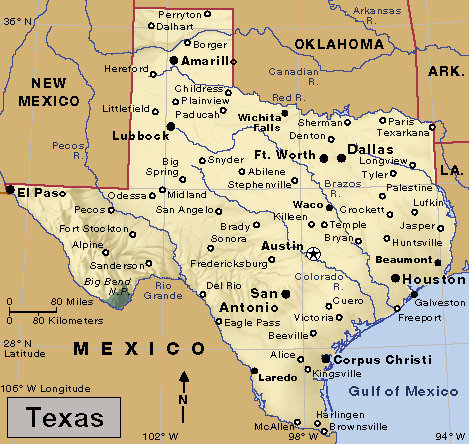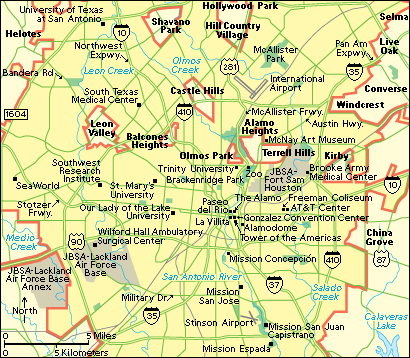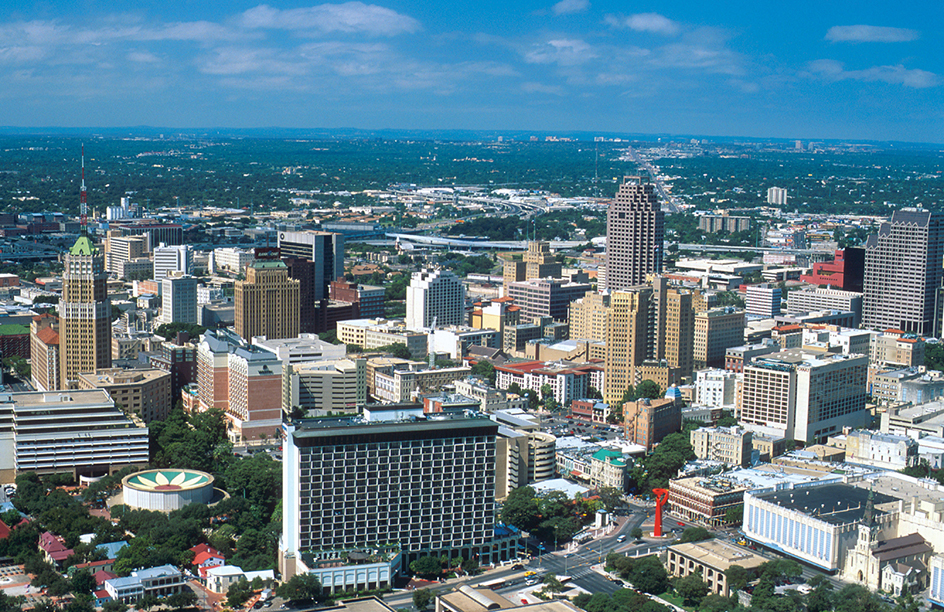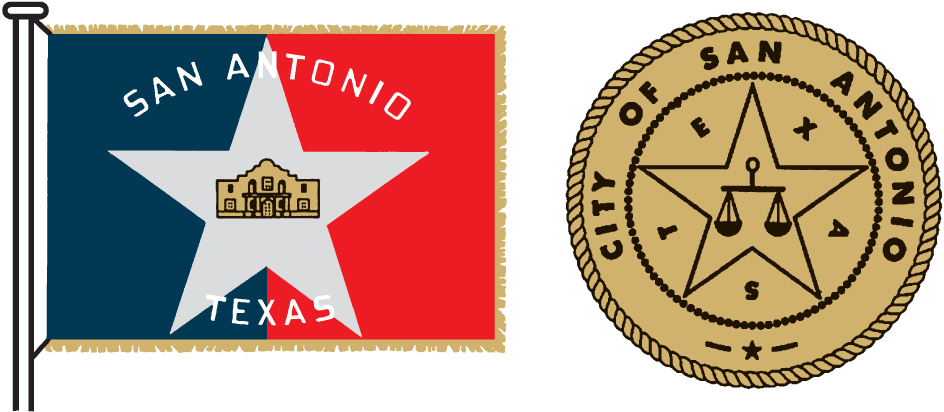San Antonio, Texas, is one of the most historic cities of the United States. During its history, San Antonio has been under the control of France, Spain, Mexico, and the independent Republic of Texas. It has been called Alamo City, in honor of the famous Battle of the Alamo that was fought there in 1836.

San Antonio ranks as one of the Southwest’s leading cultural and trade centers. Some of the largest military bases in the United States are in the San Antonio area. The city lies on the rolling prairies of south-central Texas, about 150 miles (241 kilometers) northeast of the Mexican border.
San Antonio was officially founded in 1718 when the Spanish established the mission of San Antonio de Valero and a military post at the site. The mission was later called the Alamo. The Spanish government chose this location because it wanted a settlement midway between its missions in eastern Texas and its military posts in northern Mexico. Members of an earlier Spanish expedition had named the site San Antonio for Saint Anthony of Padua.
The city.
San Antonio is in the center of Bexar (pronounced bayr) County. The San Antonio metropolitan area consists of Atascosa, Bandera, Bexar, Comal, Guadalupe, Kendall, Medina, and Wilson counties.

A bend in the San Antonio River encircles the heart of downtown San Antonio in the city’s center. River barges transport tourists through the downtown area. Shops, restaurants, and an open-air amphitheater line the riverbanks in an area called Paseo del Rio (River Walk). La Villita (Little Village) occupies a square block along the downtown riverfront. It includes restored houses and shops built by early Spanish settlers.
The Tower of the Americas rises 750 feet (229 meters) east of the river. Its observation decks offer a view of San Antonio and the surrounding countryside. The tower was originally built for HemisFair ’68, a world’s fair that celebrated the city’s 250th anniversary. North of the tower stands the Henry B. Gonzalez Convention Center. The convention center includes a convention and exhibit hall and a 2,500-seat theater. To the east of the center stands an arena, the Alamodome. The Alamo, the restored mission of San Antonio de Valero and site of the historic battle, stands in Alamo Plaza in downtown San Antonio. Other missions are south of the city’s downtown area. Northeast of downtown is the AT&T Center, a sports arena.

Residential areas spread in all directions from downtown San Antonio. Several independent communities, including Alamo Heights, Kirby, and Leon Valley, are completely surrounded by San Antonio. Other suburbs of San Antonio include Converse, Helotes, Live Oak, Schertz, Universal City, and Windcrest.
People.
Most of San Antonio’s people were born in the United States. About two-thirds are Hispanics, and nearly one-third of the city’s population speaks both English and Spanish. Other groups include people of English, French, German, Irish, Italian, or Polish ancestry. African Americans make up about 7 percent of the population.
Unlike many other large cities, San Antonio has had few racial disturbances. After World War II (1939-1945), government integration of the military bases spread peacefully into the schools and other facilities.
Economy.
Military, health care, and tourism activities contribute heavily to San Antonio’s economy. Military bases in the San Antonio area employ tens of thousands of military personnel and civilians. San Antonio is the home of Fort Sam Houston, the headquarters of U.S. Army North, U.S. Army South, and the U.S. Army Medical Command (see Fort Sam Houston ). The U.S. Army and U.S. Air Force jointly operate Fort Sam Houston and two other bases—Lackland Air Force Base and Randolph Air Force Base—in or near the city (see Lackland Air Force Base ).
Medical and research facilities in San Antonio have made the city one of the Southwest’s leading health care and science centers. The South Texas Medical Center contains numerous facilities, including hospitals, research centers, and the University of Texas Health Science Center at San Antonio. Brooke Army Medical Center at Fort Sam Houston and Wilford Hall Ambulatory Surgical Center at Lackland Air Force Base rank among the country’s largest military medical facilities. The Southwest Research Institute in San Antonio conducts research for government and industry.
San Antonio ranks as one of the leading convention cities in the Southwest. Conventions and tourism bring in millions of visitors a year.
Retail and wholesale trade activities and manufacturing are also important to San Antonio’s economy. The city is the chief outlet for farm products from the surrounding agricultural region. Many of the city’s manufactured products are exported to Mexico.
Hundreds of manufacturing firms are in the San Antonio area. Their products include aircraft parts, electronic products, food products, fertilizer, medical supplies, oil field equipment, petroleum products, and other goods.
Three interstate highways link San Antonio with other parts of the country. Several truck and railroad lines carry cargo to and from the city. The National Railroad Passenger Corporation (Amtrak) operates rail passenger service between San Antonio and other cities. The San Antonio International Airport handles flights to and from most major U.S. cities and several cities in Mexico.
The city’s daily newspaper is the San Antonio Express-News. Several television and radio stations serve the San Antonio area.
Education.
A number of independent public school districts, including a few military districts, serve Bexar County. They operate elementary schools, middle schools, and junior and senior high schools. About two-thirds of the public school students are of Hispanic ancestry. Less than 10 percent of the students are African American. San Antonio also has dozens of private and church-supported schools.
Universities and colleges in San Antonio include Our Lady of the Lake University, St. Mary’s University, Trinity University, and the University of the Incarnate Word. Two campuses of the University of Texas System are in the city—the University of Texas at San Antonio and the University of Texas Health Science Center at San Antonio. The city is also the home of a branch campus of the National Autonomous University of Mexico, the largest university in Mexico.
The San Antonio Public Library system consists of a main library and branches throughout the city.
Cultural life.
Theatergoers attend the Public Theater of San Antonio and other community theaters. The San Antonio Symphony performs at the Tobin Center for the Performing Arts.
The McNay Art Museum displays American and European art. Noted collections of the San Antonio Museum of Art include Greek and Roman sculptures, Asian art, and American paintings. One wing of the museum houses the Nelson A. Rockefeller Center for Latin American Art. The Witte Museum features exhibits on natural history. The Institute of Texan Cultures has exhibits about the various nationality groups in Texas history. The institute also hosts the Texas Folklife Festival each June.
San Antonio’s historic Alamo has been preserved as a museum. The city’s other historic Spanish missions are Concepción, Espada, San José, and San Juan Capistrano. The five structures were built during the early 1700’s. They make up San Antonio Missions National Historical Park. San José, the largest mission, is called the “Queen of the Missions.” It is known for its Rose Window, which is decorated with intricate stone carvings and offers a fine example of Spanish colonial ornamentation.
Recreation.
San Antonio has dozens of parks. Brackenridge Park includes one of the nation’s largest zoos, a sunken garden, and an outdoor theater. The city is the home of the San Antonio Spurs of the National Basketball Association.
The San Antonio Stock Show & Rodeo is held in February. The Fiesta San Antonio, held in April, celebrates the establishment of the Texas republic in 1836. This festival features parades through the downtown area. Each winter, San Antonio hosts college football’s Alamo Bowl.
Government.
San Antonio has a council-manager form of government. The voters elect a mayor and 10 council members to two-year terms. The mayor and council appoint a city manager to carry out their policies. Property and sales taxes and income from city-owned utilities provide most of San Antonio’s revenue.

History.
Coahuiltec Indians lived in what is now the San Antonio area long before European settlers first came. During the 1500’s, Spanish explorers traveled through what is now Texas. France claimed the area from 1685 until 1690, when Spain sent an expedition to reestablish its earlier claims. The Spaniards reached the Indian village of Yanaguana on June 13, 1691, the feast day of Saint Anthony of Padua. They renamed the village and nearby river San Antonio.
Spain officially founded San Antonio in 1718. That year, Father Antonio Olivares established the mission of San Antonio de Valero on a branch of the San Antonio River. Nearby, the Spaniards also established a military outpost, later named Fort San Antonio de Bexar. The mission became known as the Alamo. It was later rebuilt at its present site. In 1731, the Spanish government sent 15 Spanish families from the Canary Islands to settle in the San Antonio region and build the community. See also Mission life in America .
Mexico won independence from Spain in 1821, and San Antonio came under Mexican rule. In 1835, dissatisfaction with Mexican rule led the Texas settlers to revolt. In one of the most famous battles of the revolt, fewer than 200 Texans defended the Alamo during a 13-day siege by a Mexican army. The siege began on Feb. 23, 1836. On March 6, about 1,500 Mexican soldiers, from a force of about 5,000 that had gathered in San Antonio, stormed the Alamo and killed all the defenders. But on April 21, Texas forces defeated the Mexicans in the Battle of San Jacinto, and Texas became independent.

In 1837, San Antonio was incorporated as a city of the Republic of Texas. The city began to grow rapidly after 1845, when Texas became a state. In 1850, 3,488 people lived in San Antonio. Beginning in the 1860’s, San Antonio thrived as a stop along cattle trails to Kansas. Businesses developed to trade in leather goods and supplies for cattle ranchers. San Antonio’s first railroad came to the city in 1877. Between 1876 and 1879, the construction of what is now Fort Sam Houston established San Antonio as an important military center. By 1880, the city’s population had reached 20,550.
In the late 1800’s and early 1900’s, discoveries of oil near San Antonio aided the city’s growth. After the United States entered World War I in 1917, San Antonio served as a leading military training and supply center. This activity helped San Antonio’s population jump from 96,614 in 1910 to 161,379 in 1920.
The city’s growth rate slowed during the 1930’s. But World War II (1939-1945) stimulated new growth, as San Antonio’s military bases expanded. By 1950, the city had a population of 408,442. San Antonio more than doubled its area between 1950 and 1960 by annexing surrounding communities. These additions helped increase the city’s population to 587,718 by 1960.
During the 1960’s, urban renewal projects improved some of San Antonio’s run-down areas. A new civic center was built and many historic buildings were restored. During the 1970’s, the city built low- and moderate-cost housing for San Antonio’s growing population. In 1981, voters elected Henry G. Cisneros mayor. Cisneros became the first Mexican-American mayor of a major U.S. city. He was reelected in 1983, 1985, and 1987. Cisneros served until 1989.
The 1990 U.S. census listed San Antonio as the nation’s 10th largest city with a population of 935,933. Construction of a new sports arena, northeast of the downtown area, began in 2000. The arena opened in 2002. By 2020, San Antonio had become the seventh largest city in the United States, with a population of 1,386,932.
